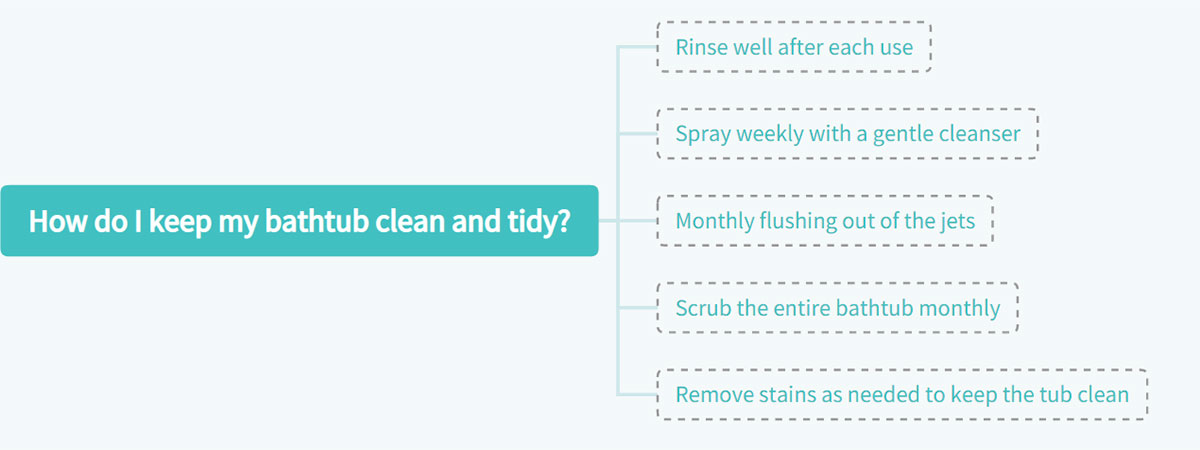Are you considering a custom bathtub, if you’re a newbie, then you’ve come to the right place. In today’s guide, we will explain why, what material, what type, and how much it costs to customize a bathtub. Read on for more information.
1. What is a custom bathtub?
A bathtub is a container to hold water where a person or animal can bathe. Most modern bathtubs are reinforced by thermoformed acrylic, enameled steel or cast iron, or glass fiber made of polyester. The bathtub is usually placed in the bathroom as a stand-alone fixture or in combination with the shower. A custom bathtub is to make a special and unique bathtub according to your own preferences and requirements.
Modern bathtubs have overflow drains and may have faucets installed on them. They are usually built-in but may be independent and sometimes recessed. Before acrylic thermoforming allowed for other shapes, almost all bathtubs were roughly rectangular. The bathtub is usually white, although many different colors can be found.
The bathtub can be rectangular or oval. They have a central drain pipe at the bottom that can clog to control the flow of water. The faucets operate the water in most bathtubs, one for cold water and the other for heating. Newer bathtubs have thermostatic mixing valves to ensure better protection at higher temperatures. The bathtub is a safe space for bathing young children. They also provide an excellent space for adults to relax after a long day at work.
(Looking for a reliable bathtub manufacturer? Your request will be met.)
2. Benefits of custom bathtubs
The biggest difference between customizing a bathtub and buying a bathtub is that it can be made according to your preferences and requirements, so it can give you a better experience. Custom bathtubs have become the first choice for experience-focused homeowners. Below, we’ll explore the benefits of a custom bathtub.
1) Increase comfort
If you want added comfort in your bathtub, a custom bathtub is your first choice. The existing bathtubs on the market focus on the experience of the general public and ignore some niche groups. Those with limited mobility or disabilities, for example. Then by customizing the bathtub, you can meet the specific requirements of these people and increase the comfort of bathing. Make your bathtub a truly relaxing place in your home.
2) Increase the sense of security
Customizing your bathtub can not only increase comfort but also increase security. For example, by using safety features such as non-slip floors, grab bars, and handheld shower heads, you can help reduce the risk of accidents.
3) Perfect appearance experience
Custom bathtubs can be completely customized to your preferences and requirements. This means it can be any style you want. From the type of flooring you choose to the color of wall paint, everything can be adjusted to suit your needs. Imagine if you could come home from work and see a completely new bathroom before your eyes. It would be very relaxing, wouldn’t it?
4) Custom shapes and sizes
If you are someone who likes to think outside the box, then a custom bathtub is perfect for you. If you’re tired of seeing the same cookie-cutter bathroom shapes and sizes on the market, you can choose to customize one to the shape and size you want. Even if the shape you want is really weird, it’s best if it’s something you like. Additionally, you can choose custom materials.
For example, if your floors are not too solid and you want to place the tub in an upstairs bathroom, a vinyl tub would be the best choice since the material is lightweight and waterproof. If your bathroom is small, a custom bathtub can be customized to fit your bathroom space, making it look larger. If you have a large bathroom, then you can choose to customize a large bathtub that will make your bathroom look smaller.
5) Durable
Most custom bathtubs these days are made from high-quality materials that prevent water from seeping into the tub. Materials like acrylic, vinyl, and fiberglass are immune to scratches and dents. Materials such as brass, stainless steel, and copper coatings are virtually rust-free, making the tub more durable.
6) Increase home value
If you want to add value to your home, investing in a custom bathroom remodel is a great way to do that. Not only will the beauty of this new space bring a special sense of satisfaction and comfort, but it will also provide a greater overall return on investment. The look and shape of a custom bathtub may stand out in the future when you decide to sell your home. Potential buyers may also like your style.
Studies have found that homes with quality bathrooms earn 7-12% more than similar homes without remodeled bathrooms. This increases the value of the home.
3. What are the materials of the customized bathtub?
The structural material of the bathtub varies greatly. Different materials have different advantages and limitations. Here we have listed several bath materials and their advantages and disadvantages. If you want to customize one, you can use it as a reference.
1) Fiberglass bathtub
Fiberglass is the cheapest material. These are manufactured by forming a bathtub shape with fiberglass resin and coating it with a gel-coated resin.
Advantages
- Lightweight and easy to install.
- Easy to repair in case of damage.
- Sand is a sustainable material and is the main component of glass fiber.
Disadvantages
- Flexible, easy to crack and scratch. Fiberglass bathtubs often feel unstable.
- Porosity is sufficient to absorb moisture, so stains may be difficult to remove.
- Colors will fade over time, especially after long and repeated cleanings.
2) Acrylic bathtub
Acrylic is similar in appearance to glass fiber and is made by heating plastic resin sheets, forming them into the shape of bathtubs, and reinforcing them with a glass fiber coating. And the price of acrylic acid was moderate.
Advantages
- Completely non-porous. Does not support mold growth or anti-stain.
- Lightweight and suitable for installation anywhere.
- Easy to clean, but abrasive cleaners are not recommended.
- We note that acrylic does not absorb heat. The water keeps it hot, which makes an acrylic tub ideal for soaking.
Disadvantages
- Sustainability is limited—petrochemical products from acrylic resins.
- Although acrylic is not as flexible as glass fiber and is prone to cracking and scratching, it can still feel unstable.
(Another related post: Bathtub Buying Guide)
3) Cast iron bathtub
The design of the modern bathtub originated with John Michael Kohler, who added legs to a cast iron manger and painted it with hard enamel to create the first claw-foot bathtub. To create a modern cast iron bathtub, molten iron is poured into a mold. Then apply a hard enamel coating.
Advantages
- Excellent durability. Highly resistant to impact and scratches.
- Good thermal insulation. There’s a reason why some of the best bathtubs are made of cast iron.
- Easy to clean and maintain. The hard enamel coating is non-porous and stain-resistant.
- Designer friendly. The bathtubs are available in a variety of colors and styles.
- Sustainable materials. Cast iron bathtubs can last long, and the materials are all recyclable.
Disadvantages
- Heavy. Waterless cast-iron bathtubs weigh between 300 and 500 pounds.
4) Enamel steel bathtub
Enameled steel, a lighter alternative to cast iron, remains a heavy bathtub material. It offers limited design options, often molded into niches and other built-in bathtub models.
Advantages
- Durable.
- Scratch and stain-resistant. Easy to clean.
- Good thermal insulation.
Disadvantages
- It is expensive compared to other materials.
- The enameled cladding will crack and wear out, and the steel will rust.
(Another related post: Bathtub Refinishing FAQ Guide)
5) Solid surface bathtub
Solid surface bathtubs are made from various polymers as a relatively new addition to the market.
Advantages
- Non-porous, stain-proof, and easy to clean.
- Excellent thermal insulation.
- Stylish and high-end appeal.
Disadvantages
- Among the more expensive bath materials.
- Not as heavy as cast iron, but still heavy and may require additional structural support.
6) Cultivate marble bathtubs
Cultured marble is made of a mixture of limestone and resin and coated with a gel coating, a class of stone resin materials made of natural crushed stone.
Advantages
- Available in a variety of styles and colors.
- Longer lasting and more durable than other materials.
- Non-porous, easy to clean.
Disadvantages
- More expensive and not as widely used as other materials.
7) Ceramic bathtub
The ceramic bathtub is reminiscent of a Roman terracotta bath, lined with tiles. This type of bathtub can be customized into any shape.
Advantages
- More design options than any other material.
- When using the Budget tile, it can be a low-ticket item.
Disadvantages
- It may be challenging to maintain. The grout is porous and can support mold if not cleaned regularly.
- Irregular tile surfaces can be uncomfortable, making this bathtub less suitable for soaking.
(Another related post: A Complete Guide for Freestanding Tub)
4. What are the common types of custom bathtubs?
The following are common types of bathtubs.
1) Standard bathtub
The most common type of bath, the standard bath, does not offer special bells and whistles but does a good job. They are usually the same size, 5 feet long, 30 inches wide, and 14-16 inches high. This is convenient for anyone who replaces an old standard bathtub and wants to replace it with a new one. These have several mounting options, including niches, plug-ins, and free-standing.
In general, the standard bathtub is your most affordable model. Most of them cost between $200-500. They are the most basic and simple option, and they can do everything you need a bathtub to do for many people. However, if you want a bathtub that brings an extra experience to your experience, one of the other options here might be worth the additional charge.
2) Soaking bathtub
The soaking tub is deeper than the standard one so that you can get a fuller soaking experience. Some soaking tubs are also wider or longer to make installation easier. They are more expensive than standard bathtubs, start at around $300, and sometimes even reach thousands of dollars.
3) Whirlpool
Whirlpools include nozzles, usually located close to where a person’s main muscle group lies in the bathtub. The power from the nozzle provides a massage-like experience that relaxes and relieves pain in people who often experience muscle or joint soreness. In general, whirlpool bathtubs are priced higher than both standard bathtubs and soaking tubs.
4) Air bathtub
Air bathtubs are similar to whirlpools, but instead of shooting water out of several strategically placed nozzles, they shoot air out of many different nozzles in a way that distributes pressure. This feeling is less concentrated, and some feel more relaxed and enjoyable.
5) Combination bathtub
None of these different experiential choices are necessarily exclusive. Soaking tubs with jets and bathtubs offer whirlpool tubs and air technology. If reading about the different options makes you feel like you can’t just choose one, look for a combination tub that offers all the experiential options you want. Of course, unsurprisingly, adding more features will mean higher costs, so be prepared to pay more for a combo tub based on what you’re looking for.
6) Walk-in bathtub
Walk-in bathtubs are not so much about indulgence as some of the other types on this list and are more about convenience and need. A walk-in bathtub can eliminate many risks for seniors or people with disabilities who struggle to get in and out of the bathtub safely every day.
(Another related post: Top 10 Bathtub Manufacturers in 2023)
5. How much does it cost to custom a bathtub?
The price of the bathtub can vary greatly depending on the raw material, Size, shape, and other factors. Here we list common bathtub prices for several different raw materials.
1) Porcelain bathtub
Porcelain is a shiny and beautiful material, and in fact, its appearance is very durable, although there are some problems with this material as a whole. It has medium insulation, the surface is very bright and shiny, which also makes it very slippery, and harmful to some people, and finally, it cannot withstand any heavy impact or scratches; otherwise, it will crack or break. The average cost of a 60-inch standard ceramic bathtub ranges from $350-$2,000, excluding installation.
2) Cast iron bathtub
Cast iron is a very durable and robust material with excellent thermal insulation that allows for longer soaking times, although the material is quite heavy and therefore requires additional support reinforcement. The average cost of a 60-inch standard cast iron bathtub ranges from $500 to $2,000, excluding installation.
3) Enamel steel bathtub
Similar to cast iron, enamel steel is much cheaper and less heavy. The only downside to this material is that it breaks easily and creates a lot of noise when the bathtub is full. The average cost of a 60-inch enameled steel drum ranges from $300 to $2,000, excluding installation.
4) Copper bathtub
Copper is seen as a luxury, and in terms of its price, it is certainly a luxury. This material is probably the most durable on the market, able to withstand every penalty without scratching, retaining heat, and never attracting mold or dirt. Although not usually required, non-abrasive cleaners can be used to remove any build-up that has occurred. It is also very pleasing aesthetically pleasing, with a rustic feel, but as mentioned earlier, this material is the most expensive on the market because they are all custom-made and the bathtub itself starts at at least $2,000, not including any additional costs.
(Another related post: How to Repair Chips & Cracks in Bathtub?)
6. How much does it cost to change the bathtub?
While the average national Cost of replacing a bathtub is $5,660, it can be as low as $750 or as much as $20,000. The wide range of cost fluctuations is mainly the result of the selected bathtub type. Other factors apply, so consider the following when estimating the Cost of a bathtub replacement project.
1) The old bathtub is removed
On average, it costs $50 to $100 to remove the old bathtub and remove it from the house. However, if the old tub is made of cast iron, it may run more, in which case the contractor may need to break it with a sledgehammer and then drag out the pieces. Baths are often installed during construction before porches are framed and trimmed, so it may not be possible to remove the old bathtub as one.
2) Material Disposal
Most urban garbage collection only covers household waste, so don’t plan to put old bathtubs and any other demolition materials on the side of the road in the expectation that they will be towed. Special provisions must be made for the disposal of construction and demolition materials, and project costs may increase by $100 to $4,200.
3) Surface treatment
In some cases, a contractor may be able to place a new bathtub in the location occupied by an old tub without having to make adjustments, but that’s not always how it works. Usually, underfloor repairs are necessary, especially if the old bathtub leaks and causes water damage. In addition, if a heavier bathtub is being installed, the floor may require additional reinforcement. These repairs and alterations could increase the price by $300 to $800.
(Another related post: A Buying Guide for Freestanding Bathtubs)
7. How do I keep my bathtub clean and tidy?
The following are some tips about how to keep your bathtub tidy.
1) Rinse well after each use
While it may seem like cleaning the tub every time you use it, any soap, oil, or bubble bath can cause a nasty build-up of slag and mucus in the long run. To avoid this, simply take one minute after each use to rinse the bathtub with plain old water. It only takes a few seconds to complete, but it can save you a lot of future cleaning time.
If your bathtub is under the shower, just run the shower for a few seconds. Or, if your tub is separate from the shower, turn on the tap and splash water with your hands, or use a spray bottle filled with tap water.
Whichever rinsing method you choose, be sure to fetch water on all bare surfaces of the tub, which will help maintain the tub over time.
2) Spray weekly with a gentle cleanser
Another equally simple measure you can take to avoid more cleaning, in the long run, is to spray the tub with a mild cup of cleaner every week. Many major cleaning brands sell spray tub cleaners designed for frequent use, and most grocery stores offer a generic version at a lower price.
However, you can make your own more natural cleanser by simply filling the spray bottle with a mixture of water and white vinegar. After spraying the tub, you can rinse off the vinegar immediately or let it sit for a few minutes for a more thorough cleaning.
If you see any signs of soap dregs, mold, or another unwanted build-up, simply use a scrub brush to locate the problem area before rinsing the cleanser – a scrubbing brush that has been treated for a long time can make this step easier.
3) Monthly flushing out of the jets
If you have a whirlpool or air bath, be sure to regularly rinse and clean its nozzles to maintain the tub. With an air bath, the process is simple: simply open the nozzle when the tub is empty, or use the bathtub’s built-in drying cycle. Either way, doing so will dry and rinse off the tub’s nozzles within minutes.
With whirlpools, cleaning is more complicated:
- First, you need to fill the tub until the water is a few inches above the nozzle.
- At this point, you can add a few glasses of vinegar to the water, or cleaning products such as bleach or dishwashing detergent (see the manufacturer’s instructions to ensure that your bathtub is not damaged).
- Then, close the air sensing valve and open the nozzle. After about 15 minutes, drain the bathtub and repeat the process.
While flushing the nozzles of the Whirlpool is undoubtedly a chore, it is worth it to prevent large pieces of debris and mold from damaging the otherwise relaxing bathtub.
Keep in mind that if you use a jet tub regularly (i.e. multiple times a week), you must also rinse its nozzles more frequently.
4) Scrub the entire bathtub monthly
About every month (if you’re a person who bathes regularly or every few weeks), you’ll need to use some good old-fashioned elbow grease to give your bathtub a thorough scrub.
You can buy a commercial bathtub scrubbing solution or make it yourself. Just mix a cup of baking soda with two to three tablespoons of liquid Castilian soap and hydrogen peroxide. For additional washing capacity, add half a cup of salt or cornstarch.
Then, use a towel or scrub brush to apply the scrubbing solution of your choice to all surfaces of the tub, paying special attention to its grouting, drain pipes, faucets, and spray caps.
You will have a sparkling bathtub completely free of any mold, mold, scum, or mineral build-up.
5) Remove stains as needed to keep the tub clean
Even with regular cleaning and maintenance, your bathtub may show some unsightly stains and discoloration over time. To fight stains naturally, spray the paint with a vinegar mixture (or undiluted vinegar if the stain is particularly severe) and sprinkle baking soda on top.
Once the area has foamed for a few minutes, use a towel or scrub brush to process the mixture into a paste. Let the paste stand for about 15 min, rinse off with water, and repeat as needed. Alternatively, you can purchase commercial detergents. To use it, simply follow the instructions on the package.
While almost everyone doesn’t like to clean a bathtub, proper maintenance can reduce overall cleaning time in the long run and help keep your tub spotless and beautiful for many years to come.
(Another related post: How to Care Bathroom Vanity?)
8. Conclusion
A custom bathtub will always be more valuable than a mass-produced bathtub because it is unique and has a personal charm. This is our collection of relevant knowledge about customized bathtubs. I hope you can have a preliminary understanding of customized bathtubs after reading the above article. If you are planning to customize a bathtub, please contact Nicemoco.
How useful was this post?
Click on a star to rate it!
Average rating 5 / 5. Vote count: 3
No votes so far! Be the first to rate this post.



















